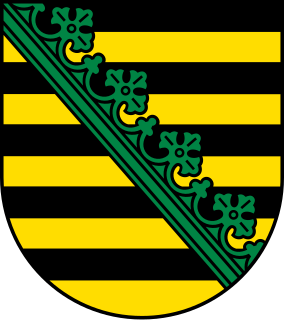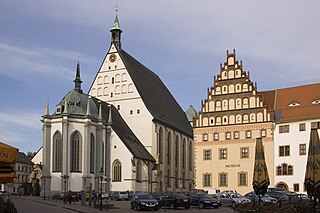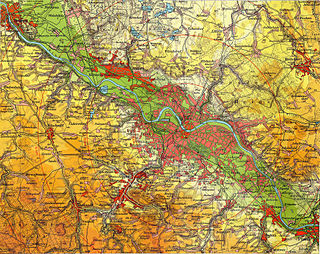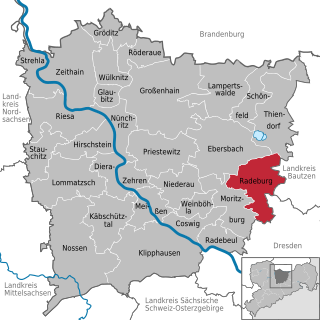
Radebeul is a town in the Elbe valley in the district of Meißen in Saxony, Germany, a suburb of Dresden. It is well known for its viticulture, a museum dedicated to writer Karl May, and a narrow gauge railway connecting Radebeul with the castle of Moritzburg and the town of Radeburg. The Meißen area, where Radebeul is located, is one of the northeasternmost areas where wine is grown in the 21st century.

The House of Wettin is a dynasty of German counts, dukes, prince-electors and kings that once ruled territories in the present-day German states of Saxony, Saxony-Anhalt and Thuringia. The dynasty is one of the oldest in Europe, and its origins can be traced back to the town of Wettin, Saxony-Anhalt. The Wettins gradually rose to power within the Holy Roman Empire. Members of the family became the rulers of several medieval states, starting with the Saxon Eastern March in 1030. Other states they gained were Meissen in 1089, Thuringia in 1263, and Saxony in 1423. These areas cover large parts of Central Germany as a cultural area of Germany.

Wurzen is a town in the Leipzig district, in the Free State of Saxony, Germany. It is situated on the river Mulde, here crossed by two bridges, 25 km east of Leipzig, by rail N.E. of Leipzig on the main line via Riesa to Dresden. It has a cathedral dating from the twelfth century, a castle, at one time a residence of the bishops of Meissen and later utilized as law courts, several schools, an agricultural college and as a police station including a prison.

The Royal Saxon State Railways were the state-owned railways operating in the Kingdom of Saxony from 1869 to 1918. From 1918 until their merger into the Deutsche Reichsbahn the title 'Royal' was dropped and they were just called the Saxon State Railways.

The Magdeburg–Leipzig railway is a double-track, electrified railway in the German states of Saxony-Anhalt and Saxony, connecting Magdeburg via Köthen, Halle and Unna to Leipzig.
The Leipzig–Hof railway is a two-track main line in the German states of Saxony, Thuringia and Bavaria, originally built and operated by the Saxon-Bavarian Railway Company. It runs from Leipzig through Altenburg, the Werdau wye junction, Reichenbach and Plauen to Hof. The Werdau–Hof section is part of the Saxon-Franconian trunk line (Sachsen-Franken-Magistrale), the line connecting Dresden and Nuremberg. Its first section opened in 1842 and it is one of the oldest railways in Germany.

The Chemnitz–Riesa railway is a two-track and electrified mainline railway in the German state of Saxony, originally built and operated by the Chemnitz-Riesa Railway Company. The line was opened between 1847 and 1852 and is one of the oldest railways in Germany. The line runs from Riesa via Döbeln to Chemnitz and is part of the Berlin–Chemnitz route.
The Dresden–Werdau railway is an electrified, double-track main line in the German state of Saxony. It runs from Dresden via Freiberg, Chemnitz and Zwickau to Werdau wye, where it joins the Leipzig-Hof railway.

Riesa station is the only passenger station of the town of Riesa in the German state of Saxony. It is a regular stop for Intercity and Intercity-Express services. The station is located at kilometer 65.8 of the Leipzig–Dresden railway. In addition, it is at the beginning of the Riesa–Chemnitz railway and the disused Riesa–Nossen railway. Since December 2013 the station has been part of the S-Bahn Mitteldeutschland network.

Priestewitz station is on the Leipzig–Dresden railway and the Großenhain–Priestewitz railway, which branches off it. The station is in the town of Priestewitz in the German state of Saxony.

The Radebeul-Kötzschenbroda station is in Kötzschenbroda, a district of Radebeul in the German state of Saxony. It is classified by Deutsche Bahn as a Haltepunkt. It is located on the Pirna–Coswig railway, which was recently created as a separate line as part of the upgrade of the Leipzig–Dresden railway. The station, which was previous called Radebeul West, was rebuilt and renamed Radebeul-Kötzschenbroda in 2013 and it is now served mainly by the Dresden S-Bahn.

Radebeul-Weintraube station is in Radebeul in the German state of Saxony. It is classified by Deutsche Bahn as a Haltepunkt. Weintraube station was opened in 1838 in the Lößnitz fields as the first station out of Dresden on Germany's oldest long-distance railway, the Leipzig–Dresden railway. It is now the oldest station still regularly served in Saxony.

Radebeul Ost (east) station is a station in the Große Kreisstadt of Radebeul in the German state of Saxony. It is in the suburb now called Radebeul-Ost. The station buildings are located within the boundaries of Alt-Radebeul on Sidonienstraße. The station is on the Dresden S-Bahn network.

Meissen station is the largest railway station in the town of Meissen in the German state of Saxony. The station was opened in 1860 in the district of Cölln. Its entrance building, which was built in 1928, is a heritage-listed building and along with the Stuttgart Hauptbahnhof it is considered an architecturally significant transport complex of the interwar period. After the ending of long-distance traffic in the 1960s, the station is now a station of the Dresden S-Bahn with only regional significance.

Siebenlehn is a district of the town Großschirma in Landkreis Mittelsachsen. Until 2003 it was a separate town. Upon fusion with the neighbouring rural municipality Großschirma on 1 September 2003, the town privileges were transferred to the joint municipality.


























